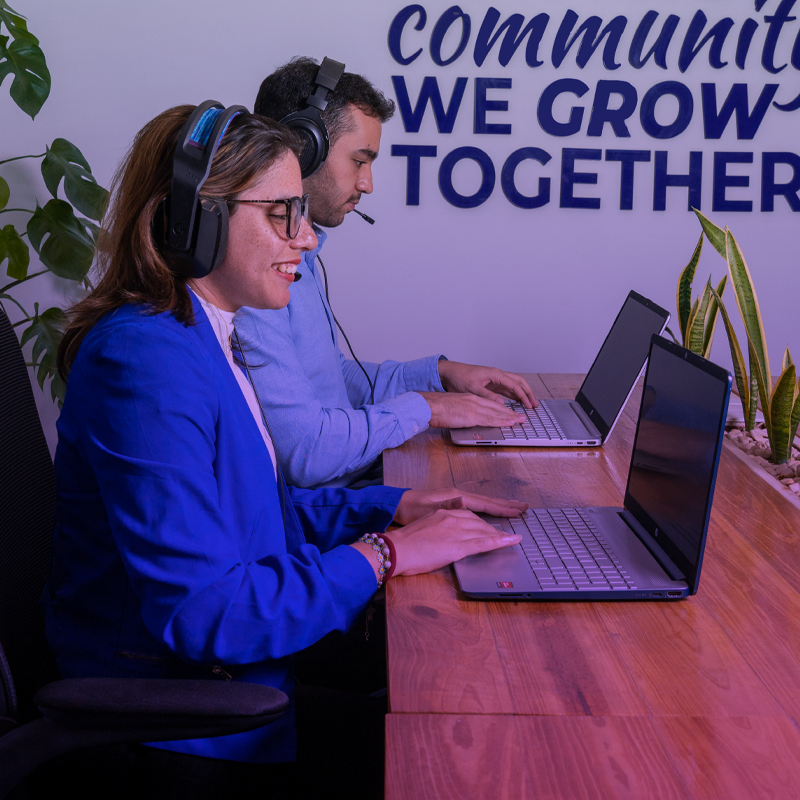I remember chatting with a founder of a small e-commerce brand out of Austin. She was pulling 12-hour days, juggling marketing, operations, and worst of all, customer service.
She told her Account Manager during that first discovery call “I spend half my day answering emails about late shipments,” absolutely exhausted. Hiring locally was too expensive. Offshoring felt risky. And the worst part is: she wasn’t alone.
That’s the case for many founders nowadays. If you’re reading this, you might be feeling the same pressure: overworked, under-resourced, and stuck in the weeds of customer support.
The truth is, customer service can either boost your brand or slowly break it down. But here’s the good news: you don’t need to shoulder the burden yourself—or pay U.S. wages to get responsive, professional help.
Thanks to modern remote staffing, especially in nearshore markets like Latin America, you can hire a top-tier customer service representative who works in your time zone, speaks fluent English, and delivers real results—without burning through your budget.
What Does A Customer Service Representative Do?
A customer service representative (CSR) is often the first human connection a customer has with your brand. Their role goes far beyond just answering calls or replying to emails — they’re the voice, tone, and problem-solving engine behind your business.
At the core, CSRs help customers with inquiries, concerns, or issues about a product or service. That could mean anything from guiding someone through a return process, resetting an account password, to troubleshooting a billing error — all while keeping calm, friendly, and solution-focused.
But in today’s remote-first world, especially when working with remote customer service representatives, the role has expanded. These professionals are trained to:
- Navigate multiple support channels (email, chat, phone, even social media).
- Use CRMs and helpdesk tools like Zendesk, HubSpot, or Intercom.
- De-escalate tense situations with empathy and professionalism.
- Represent your company’s values and tone — even across time zones.
A great CSR doesn’t just resolve issues — they build trust, boost customer loyalty, and turn negative experiences into brand wins. Whether you’re a startup scaling quickly or a growing eCommerce business, investing in the right remote customer service representative can dramatically improve how your brand is perceived and how smoothly your operations run.
Remote vs. In-Office Customer Service Representative: What’s the Difference?
When it comes to building your customer support team, one of the biggest decisions is whether to hire remote or in-office customer service representatives. Each option has its strengths, but with today’s technology and the rise of global talent, the playing field has shifted—especially for growing companies looking to scale efficiently.
Let’s break down the key differences:
| Feature | In-Office CSR | Remote CSR (LATAM) |
|---|---|---|
| Cost | ~$65,470/year + overhead (BLS, 2024) | ~$20,000–$25,000/year (avg. savings of 60%+) |
| Talent Pool | Limited to local area | Access to skilled, bilingual LATAM professionals |
| Time Zone Alignment | Local only | Fully aligned with EST, CST, PST |
| Supervision | On-site management available | Managed via clear workflows or staffing partner |
| Collaboration | Face-to-face, real-time | Seamless with tools like Slack, Zoom, CRM systems |
| Office Space Needs | Requires physical space, equipment, utilities | None — remote-ready setup included with managed services |
| Onboarding & HR | Internal onboarding, HR support needed | Fully managed: hiring, onboarding, compliance handled for you |
| Cultural Fit | Immediate exposure to company culture | LATAM CSRs trained for U.S./Canada market fit |
| Flexibility | Less adaptable to scaling up/down quickly | Scalable with flexible contracts and staffing models |
Hiring Remote Customer Service Representatives from LATAM: Key Benefits
If you’re thinking about hiring a remote customer service representative, Latin America (LATAM) should be at the top of your list—and not just for cost savings.
Here’s why more U.S. and Canadian companies are turning to LATAM for their support teams:
1. Cost-Effective Without Compromising Quality
Let’s start with the numbers. Hiring a full-time customer service rep in the U.S. can cost upwards of $65,000/year, once you factor in salary, benefits, taxes, and office overhead (source: BLS 2024). Compare that to a remote CSR from LATAM, whose total cost typically ranges between $20,000–$25,000/year—saving you over 60% while maintaining high standards.
These professionals are not “cheap labor”—they’re experienced, bilingual, and ready to deliver.
2. Time Zone Compatibility
LATAM countries like Colombia, Mexico, Venezuela, and Argentina share or closely align with Eastern, Central, and Pacific Time Zones. This makes real-time communication, daily standups, and support coverage seamless—without the late-night or early-morning headaches that come with offshore teams in Asia or Eastern Europe.
3. Strong English Proficiency & Cultural Fit
According to the EF English Proficiency Index, many LATAM countries rank among the highest in the region for English skills. Beyond language, many LATAM professionals have worked with U.S.-based companies, making them familiar with American business etiquette and customer expectations.
This cultural proximity translates into smoother conversations, better empathy, and higher customer satisfaction scores.
4. Remote-Ready Infrastructure
Post-2020, LATAM has seen a surge in remote work adoption. Talents across the region are fluent in tools like Slack, Zoom, Zendesk, HubSpot, and Freshdesk. Many already work from co-working spaces or home offices with fast, stable internet.
And if you partner with a fully managed provider like Freelance LATAM, your CSR is equipped with reliable hardware, IT support, and built-in systems for payroll, contracts, and security compliance—right from day one.
5. Focus on Long-Term Commitment
Unlike gig platforms or temp staffing agencies, the LATAM remote workforce is known for long-term partnerships and loyalty. When you hire through the right partner, you’re not getting a revolving door of freelancers—you’re building a committed support team.
Many LATAM CSRs stay with the same company for 2+ years, becoming deeply familiar with your processes, tools, and customers.
Skills To Look For In CSRs
Hiring a remote customer service representative isn’t just about checking boxes on a résumé. It’s about finding someone who will protect your brand’s reputation, delight your customers, and make your life easier—not harder.
To simplify the process, we created a free downloadable checklist you can hand off to your recruiter or use yourself. It includes everything you need to evaluate candidates quickly and confidently—from soft skills and language benchmarks to tech stack familiarity and performance KPIs. Whether you’re hiring your first remote CSR or expanding your existing team, this list will help you hire the right people, not just available ones.
Here’s what you should be evaluating when reviewing candidates for remote customer support jobs in Latin America or anywhere else:
Language & Communication
Your CSR must speak your customer’s language—both literally and emotionally. Look for:
- CEFR English level B2+ (C1 preferred) for confident, professional interactions.
- Natural tone and error-free grammar.
- Past experience serving U.S. or Canadian clients.
- Ability to write and adapt email/chat responses without heavy scripting.
Soft Skills
This is what separates good reps from great ones:
- Empathy: Can they de-escalate and humanize interactions?
- Proactivity: Do they take ownership and solve issues without micromanagement?
- Reliability: Do they consistently show up and close the loop?
- Cultural fluency: Do they “get” the tone and expectations of a North American customer?
Tools & Technical Readiness
Remote CSRs should be tech-savvy from day one. Look for candidates who know:
- Helpdesk platforms: Zendesk, Freshdesk, Intercom
- CRMs like HubSpot, Salesforce
- Collaboration tools: Slack, Notion, Google Workspace
- How to work independently across support channels (chat, phone, email)
Performance Metrics
You’re not just filling a seat—you’re optimizing outcomes. Top CSRs should understand:
- CSAT (aim for 90%+)
- Average Handle Time (AHT) under 5 minutes
- First Response Time and Resolution Rates
- Reporting and tracking KPIs within support tools
A well-chosen remote CSR from Latin America can become one of your business’s most valuable assets. Use the checklist to skip the guesswork and zero in on talent that’s ready to deliver from day one.
Frequently Asked Questions (FAQs)
1. Can I hire a remote customer service representative from Latin America with a strong English level?
Yes — many LATAM CSRs hold CEFR B2/C1+ certification and have years of experience assisting U.S. and Canadian customers. This means they speak and write English clearly, using neutral tone and grammar that matches customer expectations.
2. What are the main benefits of hiring LATAM customer support reps?
Hiring remote CSRs from Latin America gives you:
- 60–80% cost savings, with quality above offshore alternatives LATAM.Hire+7Remote Rocketship+7LATAM.Hire+7.
- Time zone alignment (EST–PST), so no awkward late-night shifts hirewithnear.com.
- Cultural and communication affinity, which enhances customer trust and brand consistency Indeed+10Nearshore BS+10LATAM.Hire+10.
3. Are there legal or compliance issues when hiring in LATAM?
It’s essential to be aware: each country has different labor laws, taxes, and benefits requirements. However, by partnering with a managed provider like Freelance Latin America, you avoid headaches—since we handle contracts, payroll, and local compliance for you.
4. How quickly can I hire a qualified remote CSR?
Many staffing solutions in LATAM offer pre-vetted candidates ready to start within days — often in as little as 24–48 hours.
5. Will a LATAM CSR blend into my team’s workflow?
Absolutely. Most remote CSRs are already fully remote-capable—comfortable with tools like Zendesk, HubSpot, Slack, Zoom — and collaborate in EST, CST, or PST time zones . With onboarding guidance, they quickly integrate like any in-office hire.
6. What performance metrics should I track with remote CSRs?
Track KPIs to ensure accountability and service quality:
- CSAT (Customer Satisfaction Score) — aim for 90%+
- AHT (Average Handle Time) — under 5 minutes
- First response & resolution rates — fast replies are crucial
- Ticket resolution efficiency and backlog control
Top LATAM CSRs routinely meet or exceed these benchmarks.
7. How do I maintain retention among LATAM remote staff?
Remote roles often bring strong job loyalty. Reliable onboarding, transparent communication, and performance recognition help maintain fulfillment and retention—resulting in long-term, reliable support .
Let’s connect.
Book a free consultation and discover how easy it is to build a high-performing support team that works when you do.
Your customers deserve better.
So do you.





